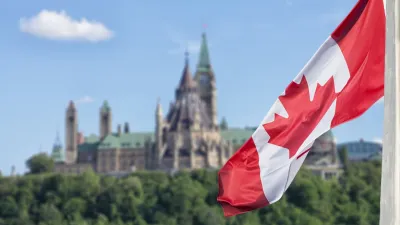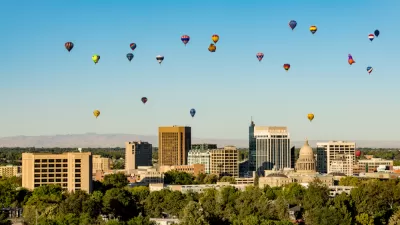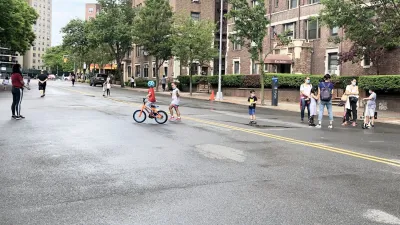How the Covid-19 pandemic taught us new ways to reclaim city streets from cars.

A new book from David L. Prytherch highlights the rapid changes made to city streets during the Covid-19 pandemic and how cities and public space advocates can build on pandemic-era success to transform American streets from vehicular thoroughfares to vibrant urban spaces. Next City published an excerpt.
Prytherch notes that, during the same time period, Americans became painfully aware of the inequity that makes even ‘open’ streets less accessible and safe for some people than others. “Though immediately focused on policing, this growing conversation encompassed a broader range of equity issues, accelerating an already robust movement for mobility justice looking beyond equity among modes to address social issues beyond the public right-of-way.”
By inviting a diversifying set of people to enter and have a stake in the roadway, and interpreting mobility justice more broadly than simply multimodal access, we come face to face with profound questions. What, exactly, do we mean by mobility justice? What and whom should public streets be for? And how ought they be shared equitably?
Prytherch explains how planners and activists must reconcile intersecting and sometimes conflicting values as they work to reclaim streets from cars and preserve the spaces created during the pandemic. “Planners struggle to balance neighborhood input, which tends to privilege the already privileged, with data-driven spatial justice. Nonetheless, these efforts to reclaim streets better approximate mobility justice than the galling inequities and unsustainability of the car-centered status quo.”
FULL STORY: Reclaiming Our Roads From Cars

Planetizen Federal Action Tracker
A weekly monitor of how Trump’s orders and actions are impacting planners and planning in America.

Canada vs. Kamala: Whose Liberal Housing Platform Comes Out on Top?
As Canada votes for a new Prime Minister, what can America learn from the leading liberal candidate of its neighbor to the north?

The Five Most-Changed American Cities
A ranking of population change, home values, and jobs highlights the nation’s most dynamic and most stagnant regions.

San Diego Adopts First Mobility Master Plan
The plan provides a comprehensive framework for making San Diego’s transportation network more multimodal, accessible, and sustainable.

Housing, Supportive Service Providers Brace for Federal Cuts
Organizations that provide housing assistance are tightening their purse strings and making plans for maintaining operations if federal funding dries up.

Op-Ed: Why an Effective Passenger Rail Network Needs Government Involvement
An outdated rail network that privileges freight won’t be fixed by privatizing Amtrak.
Urban Design for Planners 1: Software Tools
This six-course series explores essential urban design concepts using open source software and equips planners with the tools they need to participate fully in the urban design process.
Planning for Universal Design
Learn the tools for implementing Universal Design in planning regulations.
New York City School Construction Authority
Village of Glen Ellyn
Central Transportation Planning Staff/Boston Region MPO
Institute for Housing and Urban Development Studies (IHS)
City of Grandview
Harvard GSD Executive Education
Regional Transportation Commission of Southern Nevada
Toledo-Lucas County Plan Commissions





























